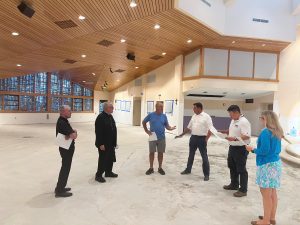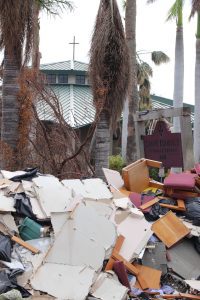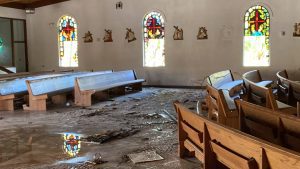The destruction wrought by Hurricane Ian in September of 2022 was unprecedented and felt across the entire Diocese of Venice, with thousands of people and hundreds of buildings affected.
In the immediate aftermath of Hurricane Ian, the Diocese of Venice, along with Catholic Charities, Diocese of Venice, prioritized the emergency needs and wellbeing of residents throughout the Diocese, including food, and shelter. This support is ongoing, even now, as many are still without homes, or jobs, resulting from that terrible storm.

Simultaneously, the Diocese’s immediate focus was on preventing further, crippling damage to the affected buildings throughout the Diocese, with the goal of getting as many Parishes back up and running as soon as possible. Bishop Frank J. Dewane, and Diocesan Chancellor Dr. Volodymyr Smeryk made an immediate tour to assess the extent of damage and offer assistance. Both have made numerous subsequent visits to monitor the progress of the recovery efforts.
Within the Diocese of Venice, the Building and Construction Department reported 93 locations (Parishes, schools, Catholic Charities, and other entities) that constituted damage reports on 841 buildings or land improvement structures (landscaping, fencing, lighting, and other infrastructure), with 404 of the buildings receiving enough significant damage to require an insurance claim and/or major reconstruction.
While huge strides have been made in most locations, there are several notable exceptions which include Ascension Parish on Fort Myers Beach, St. Isabel Parish in Sanibel, and to a much lesser extent at Incarnation Parish in Sarasota, and in Fort Myers both San Jose and Sagrada Familia Missions.
In the aftermath of Ian, mitigation work began immediately to prevent additional damage, but the widespread scope of the damage overwhelmed the available resources. Supply chain issues, as well as surging costs continue to complicate the recovery efforts.

Most significantly impacted was Ascension Parish on Fort Myers Beach, where every building on the property suffered massive damage, leaving the church destroyed. Because of the unprecedented nature of the storm damage and resulting saltwater intrusion, it was necessary to first determine what might even be possible at that location moving forward. Due to the extreme nature of the damage, as well as new and changing building codes and insurance requirements, this first decision took some time.
Bishop Dewane made several visits to the site and consulted with other areas in Florida where Parishes have been similarly drastically impacted on other occasions. Taking into consideration the pastoral needs of Fort Myers Beach, the decision was made to rebuild on the site, including preserving the existing Memorial Garden, and plans are making progress. An architectural firm as well as a construction firm have been engaged and are actively working on the site re-development.
Factors in the delay have been many, including simply clearing the massive amounts of debris from the property. It also took a year for electricity to be restored. In addition, the finalization of new FEMA requirements, including a rule for new construction to be built six feet above sea level, have slowed down attempts by the Bishop, and other Diocesan officials, to develop a concrete plan for the future.
“Although a final plan has not yet been approved, we are well on our way,” Bishop Dewane said. “I can tell you that a new church will be built at a more central location on the property, with increased capacity for parishioners. While it will not be the original church, it is going to be a beautiful new place of worship and community.”

Chancellor Smeryk explained that at Ascension Parish, and at all reconstruction efforts across the Diocese, factors in rebuilding include an emphasis on safety and durability, as well the history and beauty of the property as contributing factors.
The timeline for completion of Ascension church is anticipated to be 3-4 years, which is similar to the recovery following Hurricane Charley in 2004 when it took the same amount of time to rebuild two Parishes. Regarding staffing, Father William Adams and the Poor Sisters of Saint Clare will not be returning to the “new” Ascension; Father has recently retired, and the Sisters have elected to move elsewhere and not live under the threat of a repeat occurrence.
Many former parishioners of Ascension are no longer in the area, having returned to homes up north, or to live with family elsewhere since Hurricane Ian. Those who remain in the area have been encouraged to attend nearby St. Leo the Great Parish in Bonita Springs for Mass as well as for any other pastoral or Sacramental needs; many have found welcome there.
At St. Isabel Parish on Sanibel, the damage was also extreme, with storm surge destroying the rectory and invading the church and Parish hall. While the Holy Sacrifice of the Mass returned to the church three months after Ian, the situation was not ideal, as the church floors and walls were bare after much was removed for mitigation purposes.
The priority at St. Isabel was to first repair the Parish hall and then the focus would switch to the church. The hall was completed in the spring of 2024. At that time, the celebration of the Mass moved to the hall and the focus of the reconstruction switched to the church. That work is expected to be completed by Christmas. The rectory, which was destroyed, will be built new at a future date.
Sagrada Familia Mission in Fort Myers has had delays in its own roof repairs due to the nature of the original construction. In addition to roof repairs, the infrastructure (outdated wiring, HVAC, etc.) also need to be upgraded. This work is expected to be completed by the end of the year.
At San Jose Mission, also in Fort Myers, the Mission church had extensive flood damage and reopened in May. However, portable classrooms used for religious education were damaged beyond repair and will be replaced in the coming months.
Meanwhile, at Incarnation Parish in Sarasota, most of the major roof damage was repaired within nine months, but there has been a significant delay in completing the work. This occurred because the chapel roof is domed and has a unique skylight. While the chapel roof could have been replaced without a skylight, the necessary structural reinforcements to the building were cost prohibitive. The new skylight is expected to be installed in November, with the final roof repairs completed soon thereafter.
Bishop Dewane expressed his gratitude for the patience and understanding the faithful have shown through the arduous recovery process following Hurricane Ian.
“The resilience of the faithful has been inspiring to witness,” Bishop Dewane said. “Let us continue to pray for safety during this hurricane season in Southwest Florida.”





